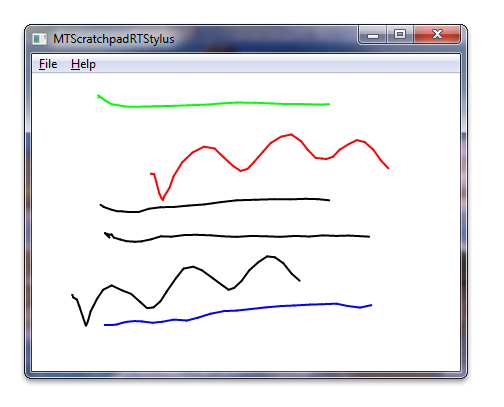Windows Touch Scratchpad usando o exemplo stylus em tempo real (C++)
O exemplo do Windows Touch Scratchpad (MTScratchpadRTStylus) mostra como usar mensagens do Windows Touch para desenhar rastreamentos dos pontos de toque em uma janela. O traço do dedo primário, aquele que foi colocado no digitalizador primeiro, é desenhado em preto. Os dedos secundários são desenhados em outras seis cores: vermelho, verde, azul, ciano, magenta e amarelo. A captura de tela a seguir mostra a aparência do aplicativo durante a execução.

Para este exemplo, o objeto RTS (Stylus em tempo real) é criado e o suporte para vários pontos de contato está habilitado. Um plug-in DynamicRenderer é adicionado ao RTS para renderizar o conteúdo. Um plug-in, CSyncEventHandlerRTS, é implementado para rastrear o número de dedos e alterar a cor que o renderizador dinâmico está desenhando. Com ambos os plug-ins na pilha de plug-ins RTS, o aplicativo Windows Touch Scratchpad renderizará o contato principal em preto e o restante dos contatos nas várias cores.
O código a seguir mostra como o objeto RTS é criado com suporte para vários pontos de contato.
IRealTimeStylus* CreateRealTimeStylus(HWND hWnd)
{
// Check input argument
if (hWnd == NULL)
{
ASSERT(hWnd && L"CreateRealTimeStylus: invalid argument hWnd");
return NULL;
}
// Create RTS object
IRealTimeStylus* pRealTimeStylus = NULL;
HRESULT hr = CoCreateInstance(CLSID_RealTimeStylus, NULL, CLSCTX_ALL, IID_PPV_ARGS(&pRealTimeStylus));
if (FAILED(hr))
{
ASSERT(SUCCEEDED(hr) && L"CreateRealTimeStylus: failed to CoCreateInstance of RealTimeStylus");
return NULL;
}
// Attach RTS object to a window
hr = pRealTimeStylus->put_HWND((HANDLE_PTR)hWnd);
if (FAILED(hr))
{
ASSERT(SUCCEEDED(hr) && L"CreateRealTimeStylus: failed to set window handle");
pRealTimeStylus->Release();
return NULL;
}
// Register RTS object for receiving multi-touch input.
IRealTimeStylus3* pRealTimeStylus3 = NULL;
hr = pRealTimeStylus->QueryInterface(&pRealTimeStylus3);
if (FAILED(hr))
{
ASSERT(SUCCEEDED(hr) && L"CreateRealTimeStylus: cannot access IRealTimeStylus3");
pRealTimeStylus->Release();
return NULL;
}
hr = pRealTimeStylus3->put_MultiTouchEnabled(TRUE);
if (FAILED(hr))
{
ASSERT(SUCCEEDED(hr) && L"CreateRealTimeStylus: failed to enable multi-touch");
pRealTimeStylus->Release();
pRealTimeStylus3->Release();
return NULL;
}
pRealTimeStylus3->Release();
return pRealTimeStylus;
}
O código a seguir mostra como o plug-in do renderizador dinâmico é criado e adicionado ao RTS.
IDynamicRenderer* CreateDynamicRenderer(IRealTimeStylus* pRealTimeStylus)
{
// Check input argument
if (pRealTimeStylus == NULL)
{
ASSERT(pRealTimeStylus && L"CreateDynamicRenderer: invalid argument RealTimeStylus");
return NULL;
}
// Get window handle from RTS object
HWND hWnd = NULL;
HRESULT hr = pRealTimeStylus->get_HWND((HANDLE_PTR*)&hWnd);
if (FAILED(hr))
{
ASSERT(SUCCEEDED(hr) && L"CreateDynamicRenderer: failed to get window handle");
return NULL;
}
// Create DynamicRenderer object
IDynamicRenderer* pDynamicRenderer = NULL;
hr = CoCreateInstance(CLSID_DynamicRenderer, NULL, CLSCTX_ALL, IID_PPV_ARGS(&pDynamicRenderer));
if (FAILED(hr))
{
ASSERT(SUCCEEDED(hr) && L"CreateDynamicRenderer: failed to CoCreateInstance of DynamicRenderer");
return NULL;
}
// Add DynamicRenderer to the RTS object as a synchronous plugin
IStylusSyncPlugin* pSyncDynamicRenderer = NULL;
hr = pDynamicRenderer->QueryInterface(&pSyncDynamicRenderer);
if (FAILED(hr))
{
ASSERT(SUCCEEDED(hr) && L"CreateDynamicRenderer: failed to access IStylusSyncPlugin of DynamicRenderer");
pDynamicRenderer->Release();
return NULL;
}
hr = pRealTimeStylus->AddStylusSyncPlugin(
0, // insert plugin at position 0 in the sync plugin list
pSyncDynamicRenderer); // plugin to be inserted - DynamicRenderer
if (FAILED(hr))
{
ASSERT(SUCCEEDED(hr) && L"CreateDynamicRenderer: failed to add DynamicRenderer to the RealTimeStylus plugins");
pDynamicRenderer->Release();
pSyncDynamicRenderer->Release();
return NULL;
}
// Attach DynamicRenderer to the same window RTS object is attached to
hr = pDynamicRenderer->put_HWND((HANDLE_PTR)hWnd);
if (FAILED(hr))
{
ASSERT(SUCCEEDED(hr) && L"CreateDynamicRenderer: failed to set window handle");
pDynamicRenderer->Release();
pSyncDynamicRenderer->Release();
return NULL;
}
pSyncDynamicRenderer->Release();
return pDynamicRenderer;
}
O código a seguir altera a cor do traço de caneta para o manipulador de eventos StylusDown no CSyncEventHandlerRTS, um plug-in RTS personalizado.
HRESULT CSyncEventHandlerRTS::StylusDown(
IRealTimeStylus* /* piRtsSrc */,
const StylusInfo* /* pStylusInfo */,
ULONG /* cPropCountPerPkt */,
LONG* /* pPacket */,
LONG** /* ppInOutPkt */)
{
// Get DrawingAttributes of DynamicRenderer
IInkDrawingAttributes* pDrawingAttributesDynamicRenderer;
HRESULT hr = g_pDynamicRenderer->get_DrawingAttributes(&pDrawingAttributesDynamicRenderer);
if (FAILED(hr))
{
ASSERT(SUCCEEDED(hr) && L"CSyncEventHandlerRTS::StylusDown: failed to get RTS's drawing attributes");
return hr;
}
// Set new stroke color to the DrawingAttributes of the DynamicRenderer
// If there are no fingers down, this is a primary contact
hr = pDrawingAttributesDynamicRenderer->put_Color(GetTouchColor(m_nContacts == 0));
if (FAILED(hr))
{
ASSERT(SUCCEEDED(hr) && L"CSyncEventHandlerRTS::StylusDown: failed to set color");
pDrawingAttributesDynamicRenderer->Release();
return hr;
}
pDrawingAttributesDynamicRenderer->Release();
++m_nContacts; // Increment finger-down counter
return S_OK;
}
Quando o valor m_nContacts for incrementado, ele alterará o conjunto de cores no renderizador dinâmico. Os traços que não são o contato principal serão desenhados com cores diferentes.
Tópicos relacionados
Aplicativo Scratchpad com vários toques (RTS/C#), aplicativo scratchpad com vários toques (RTS/C++), exemplos do Windows Touch